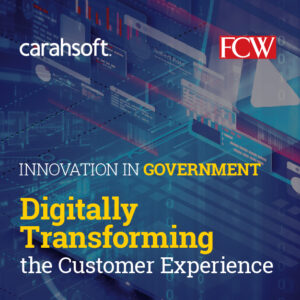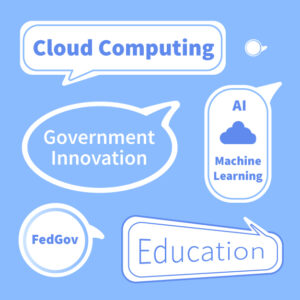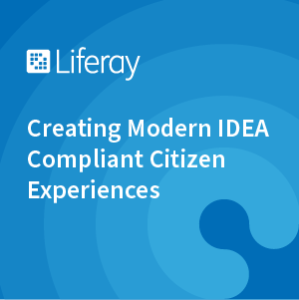The federal government first sharpened its focus on efforts to digitally transform customer experience (CX) beginning in 2018, when enhancing CX became a cross-agency priority goal and the 21st Century Integrated Digital Experience Act (IDEA) was signed into law. That’s also the year that 100% of public-sector respondents to an IDC survey said digitally transforming their organizations was a top priority. Then COVID-19 struck and reinforced the vital role that digital services play in ensuring the health and well-being of our country and the continuity of business and daily life. People turned in droves to websites, contact centers and other digital resources, often overwhelming agencies that were technologically unprepared for such an influx. Agencies need to enhance their understanding of customers so they can make better decisions about delivering services and providing important information. Agencies must also be able to build digital services quickly without compromising quality or security. And because engaged employees are essential to the delivery of government services, agencies must make sure employees have the technology and support they need to do their jobs. Read the latest insights from industry thought leaders in emerging technology in Carahsoft’s Innovation in Government® report.
Customer Experience is a Team Sport
“Many requests for government services start with a form, which can be a frustrating touchpoint. That’s why improving forms is an essential component of the 21st Century Integrated Digital Experience Act. Americans can save time and avoid frustration when they easily enter data into a mobile-friendly digital form on any device, sign it electronically and submit it securely. Digital forms also save time and effort for government employees, and they limit the opportunity for data entry errors, which further strain government resources and lead to an unsatisfactory experience for employees and citizens. Improving CX is becoming a top priority for many government agencies. Rallying the organization behind the goals and enabling employees at each touchpoint in the customer’s journey can lead to positive outcomes that everyone can be proud of. Helping everyone understand who their customers are, the major tasks they want to complete and the pain points in each customer journey is critical to any CX strategy. It can be helpful to have an agency senior leader, such as a chief customer officer, oversee all of the CX initiatives and bring the customer perspective to all conversations to drive the strategy agency-wide.”
Read more insights from Adobe’s Technical Director of Government Solutions, Jonathan Benett.
Optimizing the User Experience at the Edge
“Modernization efforts lead to improved security. Legacy systems are becoming increasingly harder to secure, particularly if they’re on physical infrastructure. The 21st Century IDEA advocates using a flexible cloud infrastructure to make it easier to improve the user experience on any device while enhancing security. As agencies seek to offer better digital services, many of them turn to responsive design engines to send websites to mobile devices. However, the time it takes for those engines to analyze and assemble a unique response to specific devices slows down the user experience, leaving citizens frustrated and unable to complete necessary tasks. What if the distance between the user and the data could be lessened? Enter the Akamai Edge. Akamai executes business logic and security policies at the edge to improve performance without compromising security. We can also put capacity rules in place at the edge to distribute the load and keep a distributed denial-of-service attack or sudden rise in traffic from affecting a website’s performance.”
Read more insights from Akamai’s Senior Solutions Engineer, Micah Maryn.
 Amplifying the Power of the Customer’s Voice
Amplifying the Power of the Customer’s Voice
“When government agencies went remote, offices stayed open virtually and services (mostly) remained available. And while those areas where government needs more digitalization (such as unemployment systems) were made even more apparent, the trains kept moving. So what is next? Government can respond by doing something it has done more of in recent years — listen. As the power of the customer’s voice reaches government, agencies that are savvy listeners and can integrate customer feedback into their service improvement plans will set the leadership tone for a responsive and digital government. Lawmakers are embracing the need for digital government. The central components of the 21st Century Integrated Digital Experience Act — modernizing websites, digitizing services and forms, accelerating the use of e-signatures, improving the customer experience, and transitioning to shared services — apply to all levels of government. Agencies understand the value of those changes, and the experience of the pandemic has given them even more incentive to make those changes.”
Read more insights from Granicus’s Vice President for Business Development, Patrick Moore.
How to Build a More User-Focused Website
“After the 21st Century IDEA was signed into law, the General Services Administration’s Technology Transformation Services published the U.S. Web Design System. This offers guidance and technology that agencies can use to create websites that are IDEA-compliant. Liferay applied the principles of the U.S. Web Design System to our platform to further streamline agencies’ ability to create websites that achieve the goals of the act. Liferay is particularly focused on facilitating action-oriented, self-service interactions. Our analytics component allows agencies to create audience segments so they can personalize the experience of website visitors based on why they use the site and what’s important to them. We also offer a more robust cloud-based analytics offering and the ability to test different versions of content to find the best way to reach the target audience. With Liferay, agencies can meet IDEA’s searchability requirement with a best-in-class capability right out of the box.”
Read more insights from Liferay’s Director of Federal, Kale Fluharty.
Government Unifies the Citizen Experience, Goes Digital
“Agencies should start thinking about creating a unified engagement layer that can house everything they know about a customer and that customer’s journey over time to ensure a positive, productive experience. That engagement layer also makes it possible for agencies to modernize back-office activities and seamlessly improve the customer experience. Thanks to the 21st Century Integrated Digital Experience Act, government agencies have been modernizing websites and digitizing forms. But those websites and forms are still disconnected from the data and still fail to address the customer life cycle. Furthermore, agencies must also embrace the other elements of the act, including adopting e-signatures, improving the customer experience and moving to shared services. Citizens, businesses and other government partners need a single front door — a place where they can engage regardless of where they are in their particular interaction. That front door service should include everything they have done and everything they could do regardless of which agency, office, department or person is handling the interaction on the government side.”
Read more insights from Salesforce’s Senior Director of Digital Transformation, Global Public Sector, Thomas Saracene.
The Next Evolution in Contact Centers
“Digitally transforming the contact center would enable agencies to leverage technology for speed and efficiency. Imagine a scenario in which a person can call the local unemployment office and talk to a “virtual agent” (or voice bot) to receive an update on their unemployment benefits, identify gaps in submissions or self-report required activity. Not only does this create a better citizen experience, it also deflects the call from a live agent, reducing strain on the contact center and allowing agents to focus on more complicated citizen requests. At Talkdesk, our goal is to automate 80% of customer interactions in the next three years. This means 80% of interactions will either be fully automated or conducted via an automated process that improves agent efficiency. The ability to scale up to handle a sudden workload influx while enabling work location flexibility will continue to be a concern. Moving systems and processes into the cloud is a foundational step on the road to digital transformation, and new deployment methods enable agencies to keep existing call-routing structures while adding cloud capabilities.”
Read more insights from Talkdesk’s Vice President of Regulated Industries, James Ward.
Download the full Innovation in Government® report for more insights from these government customer experience thought leaders and additional industry research from FCW.

 6)
6)  Overcoming Challenges to Meet Citizen Expectations
Overcoming Challenges to Meet Citizen Expectations